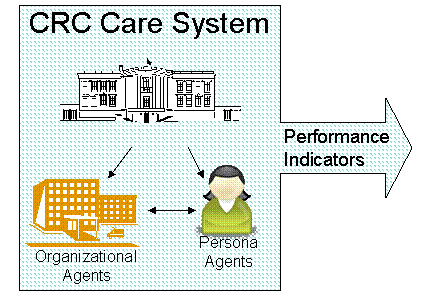574q Population-Based Colorectal Cancer Care Control
Colorectal cancer (CRC) is the second most common cause of death in the United States. Survival depends on the stage of the cancer when diagnosed, around 90% for early stage diagnosis and declining to 15% for advanced stages [1]. Therefore, it is crucial to have effective and efficient screening policies, high compliance to screening, and adequate access to necessary healthcare resources for controlling CRC in a population. This requires understanding of the current CRC care system data and the impact of different elements of the system on each other.
The CRC care system is highly complex and its performance depends on many decision makers, such as patients, service providers, and insurers/payers, often with conflicting objectives and constraints. For example, controlling cost for services, an incentive for insurers/payers, has inherent conflict with a patient's objective of receiving abundant services. Potential gaps in the quality of care exist in terms of both underutilization of services, which disproportionately affects vulnerable populations, and over-utilization resulting in increased costs with no matching benefit. Some problems in the CRC care system are due to the distributed and fragmented nature of the knowledge requiring collaborative efforts of autonomous and diverse practitioners like nurses who counsel prevention, specialists who conduct screening, and oncologists who treat patients with CRC.
Agent-based simulation modeling is a growing area with successful applications in manufacturing, consumer markets, supply chains, anti-terrorism work force, etc [2]. An agent is defined as an identity that interacts with its environment, learns and makes independent decisions with a defined goal [3]. Hence, multi-agent systems are suitable for analyzing the healthcare system and they have been applied to various health care problems [4-6].
In this work, we propose a robust and scalable multi-agent framework where characteristics of CRC care constituents (patients, hospitals, doctors, nurses, insurers/payers) and their interactions are configured to study the system behavior and identify effective control policies. The framework is composed of three major agent classes, as shown in Figure 1. Persona Agents focus on modeling behaviors of individuals involved (patients, physicians, nurses, social workers, patient-families) in CRC care by expanding MISCAN modeling [7, 8]. Some examples of the behaviors we study are degree of patient engagement, patient demographics, and physicians' evidence-based practice compliance. Organizational Agents define the environment in which persona agents interact. For example, adoption and exchange level of best practices by provider networks (hospitals, clinics, insurers/payers, medical analysis laboratories, employers, pharmacies) might influence physicians' performance. Regulatory Agents (local, state and federal government, FDA) set the healthcare system rules under which organizational agents function. They define the type of allowable insurance plans, pricing and settlement rules like cap on malpractice insurance and pay for performance, and patient driven healthcare incentives (taxes and patient tariffs).
In this presentation, patient and physician agents, and their interactions in the developed framework are discussed. Indiana is used as the pilot site and the agents are populated with the Indiana CRC care system data. The preliminary analyses show that we can approximate the current state of Indiana CRC incidence rates. Further validation and verification of the model is in progress.

Figure 1. CRC Care System
* Authors are listed in alphabetical order.
References
- Mitchell, E., Macdonald, S., Campbell, N.C., Weller, D., and U. Macleod. Influences on pre-hospital delay in the diagnosis of colorectal cancer: a systematic review. British Journal of Cancer, 2008. 98: p. 60-70.
- Drogoul, A., D. Vanbergue, and T. Meurisse. Multi-Agent Based Simulation: Where are the Agents? in Multi-Agent-Based Simulation Conference (MABS'02). 2002. Bologna, Italy: LNCS, Springer-Verlag.
- Macal, C.M. and M.J. North. Tutorial on agent-based modeling and simulation. In Proceedings of 37th Winter Simulation Conference. 2005. Orlando, FL, United States: Institute of Electrical and Electronics Engineers Inc., New York, NY 10016-5997, United States.
- Nealon, J.L. and A. Moreno, Agent-based applications in health care, in Applications of Software Technology in the Health Care Domain, J.L. Nealon and A. Moreno, Editors. 2003, Whitestein Series Software Agent Technologies: Basel, Switserland. p. 3-18.
- Beer, M., et al., An agent-based architecture for managing the provision of community care - The INCA (Intelligent Community Alarm) experience. AI Communications, 2003. 16(3): p. 179-192.
- Kanagarajah, A.K., et al. An exploration into the uses of agent-based modeling to improve quality of health care. in 6th International Conference on Complex Systems. 2006. Boston, MA.
- Habbema, J.D., et al., The MISCAN simulation program for the evaluation of screening for disease. Comput Methods Programs Biomed, 1985. 20(1): p. 79-93.
- Loeve, F., et al., The MISCAN-COLON simulation model for the evaluation of colorectal cancer screening. Comput Biomed Res, 1999. 32(1): p. 13-33.